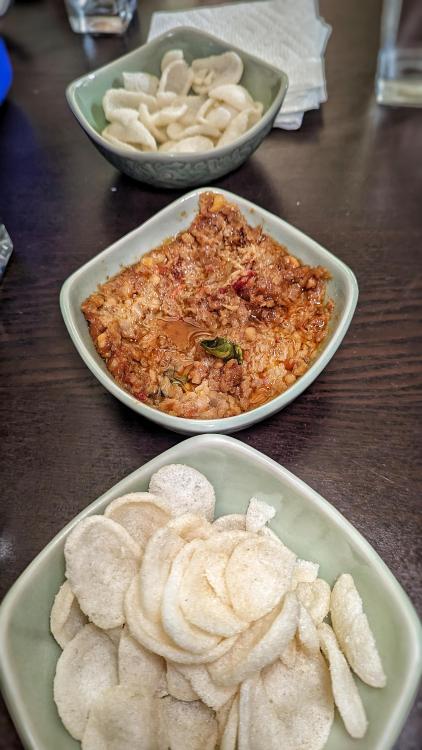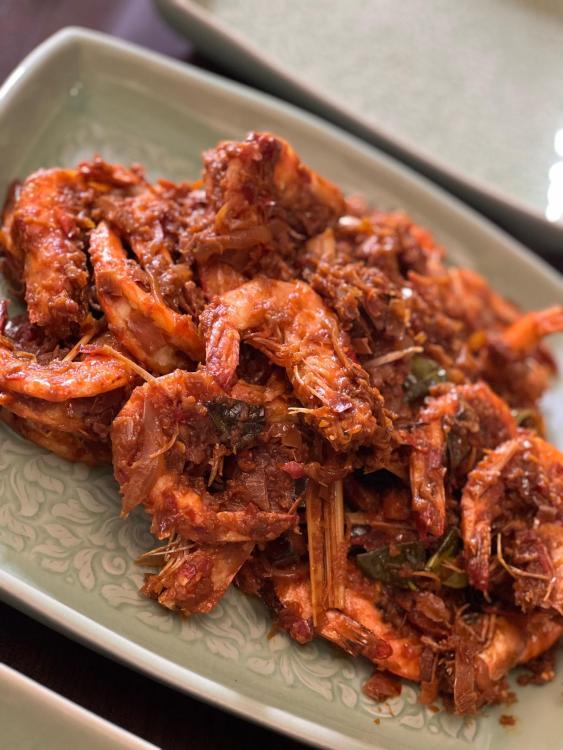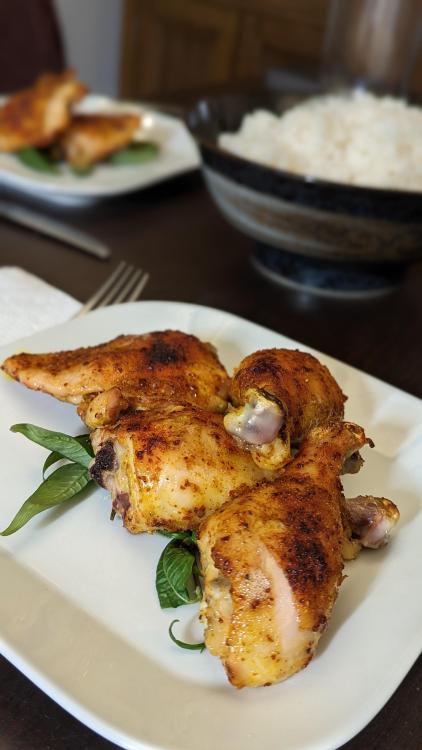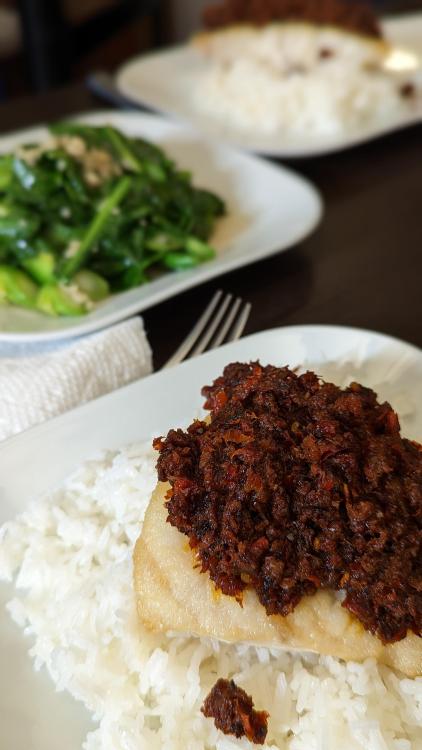
KennethT
participating member-
Posts
6,878 -
Joined
-
Last visited
Content Type
Profiles
Forums
Store
Help Articles
Everything posted by KennethT
-
This is a popular vegetable treatment in Singapore and Malaysia - vegetable stir fried with a lot of shrimp paste. It's super savory and quite addictive. Typically it's made using kang kong, aka water spinach or morning glory. Pak boong in Thailand. It's hard to get here unless I go to Chinatown, but I commonly make it with baby bok choi. 1 pound vegetable, raw. If using bok choi, separate the stem from the leaves. Cut the leaves in 3-4" pieces and the stem into 1" lengths. rempah: 6-7 small shallots 5 cloves garlic 3 fresh long red chilli 2 fresh red Thai chilli 1T toasted* belacan (preferably the Malaysian kind) 3T dried shrimp soaked for about 20 minutes, then drained 1. Pound the rempah ingredients in a mortar or in a food processor until moderately fine and set aside 2. Roughly chop the drained dried shrimp then fry in some enough oil to basically deep fry until fragrant and crispy - remove the shrimp and drain on paper towel, reserving the oil. You can use some of the oil to fry the rest but you won't need it all - keep it in the fridge (strained first) and you can reuse over and over. 3. Using a few Tablespoons of the reserved oil, fry the rempah until very fragrant and the oil starts to seep through 4. Add the stems and stir fry for a short while 5. Add the leaves and about 1/4C water and stir fry until the leaves have mostly wilted 6. Add the fried dried shrimp and toss through 6. Taste and season as necessary with a little salt and a little sugar (maybe 1/2t?) if needed
-
Indonesians love crackery things called kerupuk. They can be served along side a main meal or just eaten on their own with various sambal. Kerupuk are typically purchased in the market and can be made from a variety of things - shrimp, fish, tempeh, various kinds of legumes, etc. One very popular sambal is sambal kacang which is very similar (and can also be used for) a dipping sauce for satay - although in Indonesia, most satay dipping sauce is sweet soy sauce with chillies, but the sambal kacang is popular in Singapore with satay. bumbu: 4 small shallots 5 cloves garlic 2-3 fresh long red chillies - like prik chee faa in Thailand 2-3 fresh red Thai chillies depending on how spicy you like it 1 inch galangal A couple handful roasted peanuts (about 100g) 1 cup water 3 kaffir lime leaves 1T palm sugar 2T coconut milk 1T sweet soy sauce (kecap manis) 1/2t salt 1/4t MSG 1. Pound the peanuts in a mortar until you get a coarse sand with lots of pieces about 2mm in diameter and set aside 2. Pound the bumbu ingredients in a mortar or grind in a food processor until quite fine 3. Fry the bumbu in some peanut oil until some of the oil seeps through again and is quite fragrant 4. Add the ground peanuts and stir to combine 5. Add the rest of the ingredients and boil until thickened - note that it will thicken more once cooled 6. Taste and adjust seasoning if necessary
- 1 reply
-
- 7
-

-

-

-
yes - I just got it. It's a high power (2600W) Vollrath induction unit. Unlike most induction units, it doesn't pulse the power to control heat (like most microwaves) but rather puts out continuous limited power. It is also adjustable in 1% increments from 1 to 100. According to Vollrath, you can even use it to melt chocolate without a bain marie since it's capable of providing very low power. It also has a temperature probe so you can control it by temperature rather than % of total power - I haven't used that function yet. You can also set the pan temperature without the probe, but I haven't found that feature very accurate in my initial trials. But for the few things I've used it for so far - I love it.
-
frozen.... not nearly as good as fresh but better than nothing
-
Had a few friends over for dinner for Malaysian/Indonesian night... Store bought shrimp chips with homemade peanut sambal (sambal kacang) Sambal udang kecombrang - shrimp sambal made with torch ginger flower. The head on/shell on shrimp were deep fried first to make the head and shell crunchy and edible. Then tossed in the sambal Peranakan chicken curry with homemade curry powder All served with jasmine rice and bok choy two ways - stir fried with garlic and belacan style with tons of shrimp paste (didn't get a photo of that).
-
Where did you find a 2.75# chicken? I'd love to find something like that. Was that the Euro style Bobo chicken?
-
Nice. How was cleanup after that? Did it make a lot of smoke? Did you happen to get a couple of shots of it in action?
-
That you know of! I'd be shocked if it wasn't used extensively at Wu's.
-
Canned tuna fish. I can't get past the smell and the fact that it reminds me of cat food, which I also can't stand the smell of! (the wet food)
-
Fascinating! I had no idea! Thanks!
-
Fascinating. I'm amazed that you have it in Denmark at all. I wonder if the cost is based on the small amount of supply? In SE Asia (and probably China too but I haven't seen it myself) insects in the local markets are REALLY cheap. Much cheaper than anything else that I saw in the same markets. Lots of times, they were already prepared - like deep fried and salted to be eaten as a snack. What was expensive was the ant larva in Northern Thailand, but that's because it's considered a delicacy and is difficult to obtain. I've never seen insects for consumption anywhere in the US. the only insects I've seen are usually in either pet stores for feeding snakes and other reptiles.
-
No, this is it: https://en.wikipedia.org/wiki/Syzygium_polyanthum
-
That would make a lot of sense. But even if it was only invented in the early 1900s, it has been widely adopted in Asia. I've seen it widely used in every country I've visited. Maybe not in "traditional" recipes that aren't common anymore, but certainly in what people eat every day. As to why that didn't happen in Europe, I can't imagine.
-
Most places around the world (other than the US) call them prawns regardless of size. What we in the US would call prawns, I've seen overseas called scampi, even though, to those in the US, scampi is a preparation, not an ingredient. but then I've also seen langoustine called scampi also (not in the US) so who knows!
-
Sorry - I wasn't clear. I was saying that cookbooks in Asia (not written by western people) commonly have MSG as ingredients, but like you, I've never seen it used in a western cookbook - US or Europe. so I wasn't surprised that you've never seen it if you don't have any cookbooks from Asia.
-
That's not surprising. My Nyonya cookbook (I got from the NY Public Library but is from Singapore) has MSG in maybe 3/4 of the recipes.
-
When I go to Indonesia in July I'm looking to bring back an Indonesian bay plant - it's a different plant to Turkish or CA. I love it and so many dishes need it. It also gets really big, but with pruning it'll be fine. Also if you keep it in a container it will limit how big it gets.
-
Yeah, the Knorr stuff is REALLY salty. I much prefer the Lee Kum Kee Premium Boullion powder which is not very salty (it does have some salt and sugar) so it doesn't really factor into how much additional salt I add - or maybe it does and I factor it in with it subconsciously?
-
I do this for stir fried vegetables - I use a combo of salt, MSG and sugar. It's amazing that people can eat vegetables cooked any other way! Also - to make EVEN BETTER - add some chicken powder! I have some chicken powder that has no salt or MSG so I don't need to adjust my combo - I don't know exactly what it is, but I love it - makes basically everything better.
-
I use it regularly as well. Don't need much.
-
Tokaj is known for its sweet wines. My wife was brought there to visit Oremus which is a sweet wine made by the same company that owns Vega Sicilia in Spain. https://www.temposvegasicilia.com/en/presentation/wineries/5/tokaj-oremus I have no idea what I'm going to do with either the sweet paprika or the chilli paste - I have literally zero experience with Hungarian food - eating or making. I'm open to any and all ideas!
-
Kaya toast is tasty and there are lots of places to get it. My favorite place is the original location of Killiney's Kopitiam - unlike just about everyone else, they toast the bread over charcoal which is nice. But personally, I think the best breakfast there is the chicken curry with roti prata!
-








